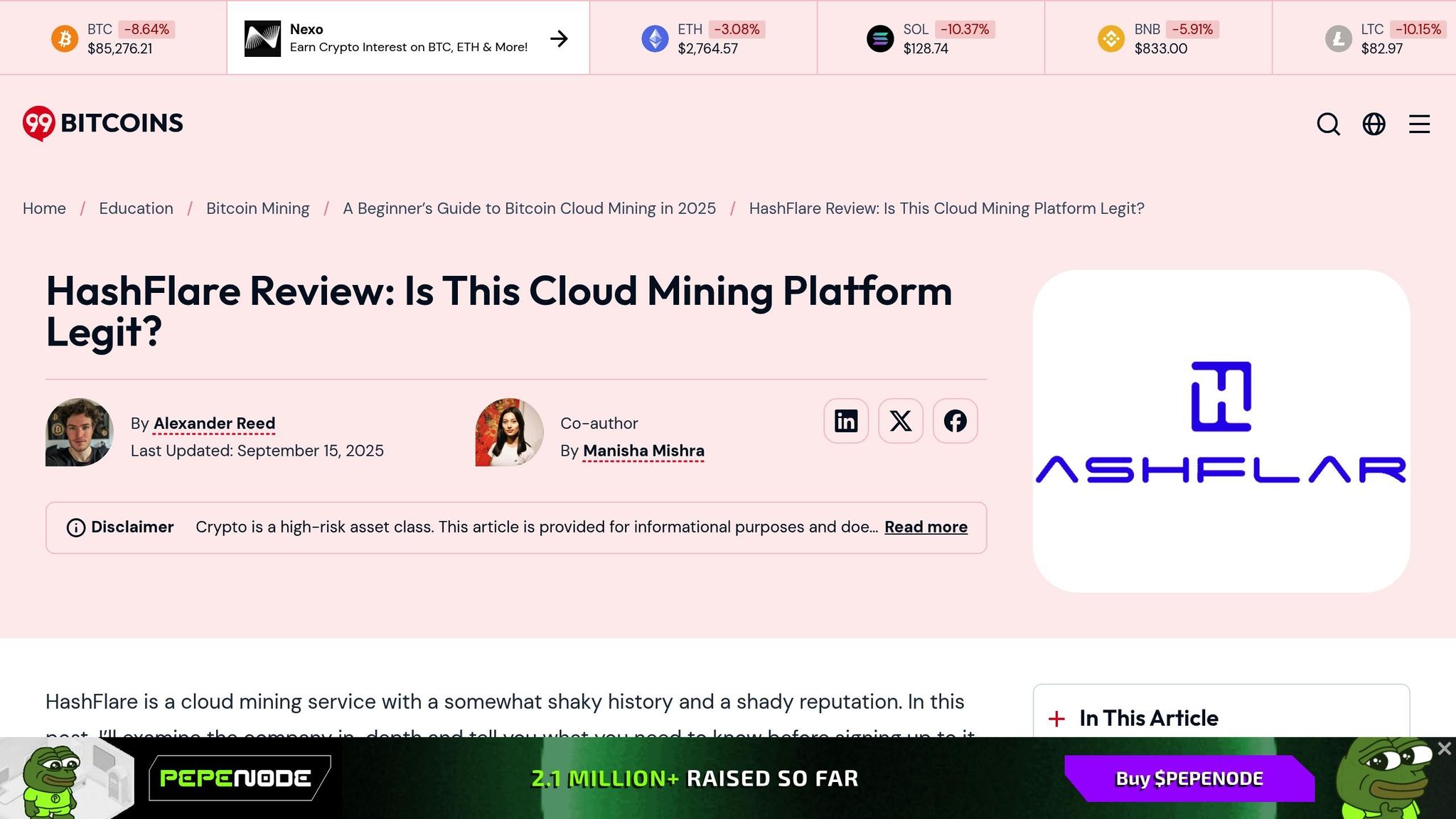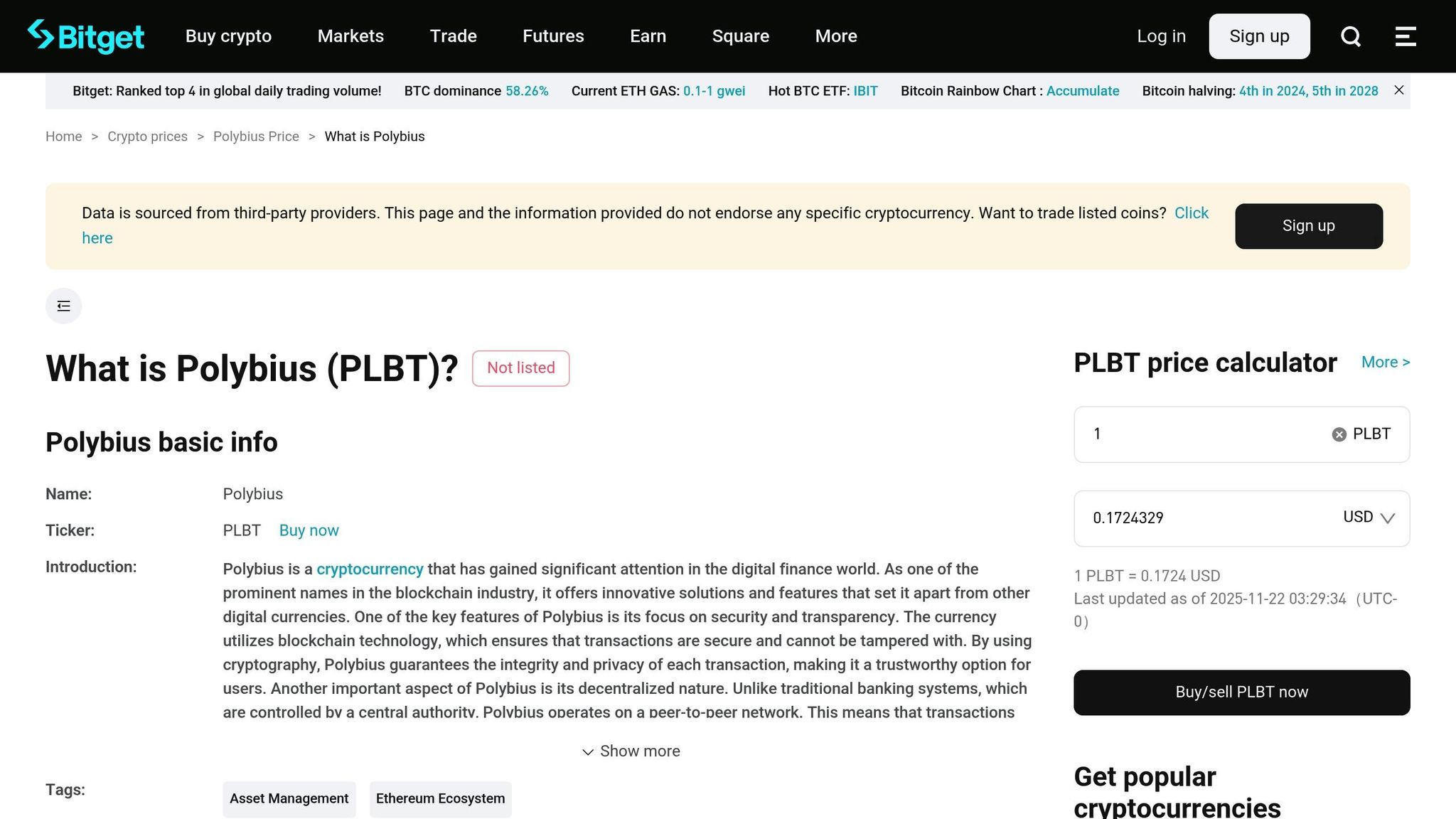HashFlare, once a popular cloud mining platform, swindled investors out of $577 million by selling fake cryptocurrency mining contracts and fabricating profit reports. The scheme, led by Estonian entrepreneurs Sergei Potapenko and Ivan Turõgin, operated from 2015 to 2019, exploiting the growing interest in Bitcoin mining. Investors were lured with promises of passive income, only to face blocked withdrawals and eventual financial losses. Here's a quick breakdown:
- What Happened: HashFlare sold fake mining contracts and displayed false profits on user dashboards.
- Who Was Behind It: Estonian founders Sergei Potapenko and Ivan Turõgin.
- How It Collapsed: By 2018, withdrawals were restricted, and the platform shut down in 2019.
- Impact: $577 million stolen, plus $25 million from a related scam called Polybius.
- Legal Outcome: The founders were arrested in 2022, pleaded guilty in 2025, and forfeited $400 million in assets.
This case highlights the importance of verifying any cloud mining service, as scammers often exploit the lack of transparency in the crypto space. Always look for clear proof of operations, realistic returns, and accessible withdrawal processes to protect your investments.
HashFlare Ponzi Founders Get Time Served for $577M Crypto Scheme,

HashFlare Timeline and the People Behind It
HashFlare's fraudulent operations unfolded over time, masterminded by two Estonian entrepreneurs during the cryptocurrency boom. The scheme began with the launch of HashFlare.io under the umbrella of HashCoins OU.
From HashCoins to HashFlare: The Beginning
HashFlare's roots trace back to HashCoins OU, an Estonian company that introduced HashFlare.io around 2015. Marketed as a cloud mining platform, it promised investors the opportunity to rent computing power and earn a share of cryptocurrency mining profits. The platform offered five types of mining contracts: SHA-256 (Bitcoin), ETHASH (Ether), Scrypt, DASH, and ZCASH. This setup was presented as a lucrative investment in the growing world of cryptocurrency mining.
The Architects: Sergei Potapenko and Ivan Turõgin
Sergei Potapenko and Ivan Turõgin were the key figures behind HashFlare. They leveraged the public's limited understanding of cryptocurrency mining to execute their scheme. As U.S. Attorney Nick Brown from the Western District of Washington put it:
"The defendants capitalized on both the allure of cryptocurrency, and the mystery surrounding cryptocurrency mining, to commit an enormous Ponzi scheme."
Potapenko and Turõgin created a polished online presence for HashFlare, complete with various mining contract options and fabricated performance metrics. This gave the illusion of a legitimate mining operation, further enticing investors to part with their money.
The Collapse of HashFlare
HashFlare's downfall exposed the intricate web of deceit it had been built upon. Over time, cracks in the operation became impossible to ignore. Investors realized that much of the advertised mining capacity was fictitious, revealing the platform as little more than a digital smokescreen designed to siphon funds. As trust in the operation crumbled, the entire scheme unraveled, laying bare its fraudulent core.
How HashFlare Deceived Investors
HashFlare's fraudulent operations led to devastating financial losses, with $577 million stolen from thousands of investors. The scheme unfolded in several calculated stages, each designed to mislead and exploit unsuspecting individuals. Here's a closer look at how these deceptive practices played out.
Fake Mining Operations and False Data
At the heart of HashFlare's scam was its fabricated mining operations. The company showcased dashboards filled with seemingly authentic data, including daily returns, hash rates, and profits. However, these numbers were nothing more than illusions. HashFlare lacked the actual mining power to back the contracts it sold. Instead of running legitimate mining farms, founders Potapenko and Turõgin manipulated online metrics and created fake profit distributions to lure more investments.
Blocking Customer Withdrawals
As the scheme began to unravel, HashFlare shifted tactics to restrict investors from accessing their funds. Initially, the platform processed early withdrawals by using bitcoin purchased from third parties, rather than profits from mining activities. Between 2015 and 2019, withdrawal requests were delayed or replaced with payments sourced from new deposits. This approach became unsustainable as the number of users grew and withdrawal demands exceeded incoming funds.
The situation took a sharp turn in July 2018 when HashFlare drastically scaled back its cloud mining services, effectively halting withdrawals entirely. By 2019, the platform disappeared altogether, suspending key services and leaving thousands of investors worldwide without access to their money. Acting U.S. Attorney Teal Luthy Miller described the operation as a "classic Ponzi scheme, involving a glitzy asset: a mirage of cryptocurrency mining".
Polybius: The $25 Million Side Scam

In addition to HashFlare, the founders orchestrated another fraudulent venture called Polybius. This side project raised $25 million under false pretenses, further highlighting their calculated and systematic approach to deception.
Where the Stolen $577 Million Went
After deceiving hundreds of thousands of investors across the globe, Sergei Potapenko and Ivan Turõgin didn’t stash their illicit gains in offshore accounts. Instead, they converted the stolen cryptocurrency into physical assets and diverse investments, giving their ill-gotten wealth a veneer of legitimacy.
This transformation was carried out through a series of calculated financial maneuvers.
How They Hid the Stolen Money
Potapenko and Turõgin used intricate money laundering techniques to disguise their profits. Rather than letting large sums linger in easily traceable accounts, they funneled the cryptocurrency into assets that appeared legitimate. This was done through shell companies and falsified contracts, allowing them to move money across borders while avoiding detection.
"They tried to conceal their profits through properties, bank accounts and virtual currency wallets around the world." - Nick Brown, US Attorney for the Western District of Washington
They also maintained multiple investment and cryptocurrency accounts for personal use, all funded by their fraudulent activities.
What They Bought with Stolen Money
The stolen funds fueled a life of luxury. Potapenko and Turõgin purchased 75 real estate properties, six high-end vehicles, lavish jewelry, private jet charters, and thousands of cryptocurrency mining machines. They even spread their wealth internationally, investing in Estonian real estate, foreign bank accounts, and luxury cars. This deliberate strategy of diversifying their assets was designed to obscure the origins of their wealth.
However, their extravagant spending eventually drew the attention of authorities, triggering a global investigation.
Police Seizures and Asset Recovery
Despite their elaborate efforts, the laundering schemes began to unravel, leading to an international crackdown. The FBI’s Seattle Field Office spearheaded a global operation to dismantle HashFlare, working closely with Estonian authorities, including the Cybercrime Bureau of the Estonian Police and Border Guard, the Estonian Prosecutor General, and the Ministry of Justice and Digital Affairs. In November 2022, both Potapenko and Turõgin were arrested in Tallinn, Estonia, and later extradited to the United States.
By February 2025, the pair pleaded guilty to conspiracy to commit wire fraud and agreed to forfeit over $400 million in assets - roughly 70% of the $577 million they stole. These forfeited assets include their extensive real estate holdings, luxury vehicles, cryptocurrency accounts, and cash reserves. The U.S. Justice Department has announced plans to redistribute these funds to victims through a remission process.
"The Justice Department plans to set up a process for victims to obtain repayment of lost funds. As soon as we have additional information from the Money Laundering and Asset Recovery Section, we will publish notice of that process, and likely also attempt to contact victims directly." - U.S. Attorney's Office for the Western District of Washington
This recovery effort marks one of the largest cryptocurrency fraud crackdowns in history, showcasing how even the most sophisticated laundering operations can be dismantled through coordinated international collaboration.
sbb-itb-c71a7d0
How to Spot and Avoid Cloud Mining Scams
The HashFlare fraud is a stark reminder that subtle warning signs can lead to significant financial losses. By recognizing these red flags and conducting thorough due diligence, you can protect yourself from similar schemes that continue to surface in the Bitcoin mining world.
Warning Signs of Mining Scams
One of the clearest red flags is promises of fixed, unrealistic returns. Mining profits naturally fluctuate due to changing network conditions and operational costs. Any platform guaranteeing consistent payouts, regardless of market trends, warrants skepticism.
Lack of transparency is another major concern. Scammers often avoid sharing specific details about their mining operations, such as the location of their facilities or the type of equipment they use. They might rely on generic images of data centers or dodge direct questions about their hardware.
Pressure tactics are also a common ploy. Beware of countdown timers or "limited-time" offers that push you to invest quickly. Legitimate mining services don’t rely on urgency to attract customers.
Withdrawal restrictions and delays can signal trouble. While small delays can be normal, scam platforms often impose unreasonable withdrawal limits or create complex verification processes to discourage withdrawals.
Lastly, anonymous or unverifiable leadership is a serious warning sign. Credible companies have identifiable leaders with proven expertise in mining and a track record you can verify.
Recognizing these signs is a crucial step in protecting your investments.
Steps to Protect Your Investment
To safeguard your money, start by verifying detailed information about the mining company. Check their registration, licensing, and operational history through official databases and regulatory filings. Look for inconsistencies or gaps in their records.
Understand the business model. Legitimate mining companies generate revenue by mining Bitcoin and distributing returns after covering operational expenses. If the process seems unclear or overly complicated, proceed with caution.
Start small and monitor closely. Make an initial investment that you can afford to lose and track the company’s performance. Compare their payouts to broader Bitcoin network conditions and industry benchmarks. Keep detailed records of all transactions and communications for reference.
What Real Mining Services Look Like
Genuine mining services operate with transparency and accountability.
Full disclosure about operations is a key characteristic of legitimate providers. They openly share information about their facilities, equipment, and processes. They also explain how funds are used and how profits are calculated.
Realistic expectations are another hallmark. Reliable providers acknowledge that mining profits vary based on Bitcoin’s price, network difficulty, and operational costs.
Some trustworthy services even offer direct ownership of mining equipment. Customers can purchase actual hardware hosted in professional facilities, giving them tangible assets and clearer ownership rights.
Sustainable energy practices are becoming increasingly common among reputable companies. Many highlight their use of renewable energy or partnerships with green energy providers, reflecting a commitment to responsible operations.
Lastly, professional customer support is essential. Real mining services provide responsive support teams and maintain clear communication about any changes or issues affecting customer accounts.
For example, Sazmining exemplifies these qualities. They provide a fully managed Bitcoin mining service powered by renewable energy in Paraguay. Customers gain actual ownership of mining equipment, detailed performance tracking, and direct Bitcoin payouts, all without hidden fees or withdrawal restrictions. This transparent approach directly addresses the pitfalls seen in scams like HashFlare.
Legal Results and Lessons from HashFlare
The fallout from the HashFlare scandal not only exposed the extent of fraudulent activities but also served as a wake-up call for the cryptocurrency industry. It highlighted serious consequences for those involved in such schemes and underscored critical lessons for investors navigating the volatile world of crypto mining.
Criminal Charges and Victim Compensation
The legal proceedings against Sergei Potapenko and Ivan Turõgin revealed the staggering scale of the fraud. Prosecutors established that the two had defrauded hundreds of thousands of people globally, misappropriating over $577 million between 2015 and 2019. As part of their legal resolution, the defendants agreed to forfeit assets worth more than $400 million, which will be used to compensate victims. This case stands as a stark reminder of the legal and financial repercussions of fraudulent activities in the cryptocurrency space.
Key Takeaways for Investors
The HashFlare case offers crucial insights for cryptocurrency investors. One of the most glaring red flags was the promise of high, fixed returns - an often-telltale sign of a Ponzi scheme. Investors are urged to independently verify any operational claims made by mining companies. Fraudsters in the HashFlare case also relied on social engineering tactics, such as fabricated testimonials and exaggerated promises, to exploit investor trust. These tactics emphasize the importance of seeking transparency and conducting thorough due diligence before committing funds.
How Sazmining Stands Apart

In contrast to fraudulent operations like HashFlare, Sazmining has established a business model rooted in transparency and accountability. The company prioritizes verifiable operations, ensuring customers have clarity and confidence in their investments.
A key aspect of Sazmining's approach is its focus on renewable energy. Its data centers in Paraguay are powered by sustainable energy sources, and customers can independently verify both the location and the company's energy practices. Additionally, Sazmining offers direct equipment ownership, where customers purchase physical mining rigs. This eliminates reliance on unverifiable claims and provides tangible security for investors.
Sazmining also adopts a no-markup pricing model, with clear monthly fees and a 90% annual rig performance guarantee. Investors can track their mining results in real time through detailed customer dashboards. By operating under a Mining-As-A-Service model, Sazmining aligns its success with the profitability of its customers, offering a transparent and sustainable alternative to the deceptive practices that have plagued the industry.
Protecting Your Bitcoin Mining Investments
When it comes to safeguarding your Bitcoin mining investments, due diligence is your strongest shield against fraud. With scams like the $577 million theft exploiting the complexities of Bitcoin mining, taking proactive steps is crucial to avoid falling victim. Here’s how you can secure your investment.
Start with thorough research. Before committing any funds, dig deep into the mining operation. Legitimate companies won’t shy away from transparency - they’ll allow facility tours, offer independent audits, and provide proof of equipment locations. If a company hesitates to share this kind of information, consider it a major warning sign.
Be cautious of too-good-to-be-true promises. Scams like HashFlare lured investors by guaranteeing consistent profits, regardless of Bitcoin’s price swings or mining difficulty changes. But the reality is far different. Bitcoin mining comes with inherent risks tied to market conditions, equipment reliability, and operating expenses. Any service offering "guaranteed returns" should set off alarm bells - legitimate operations typically show profit variations that reflect real-world conditions.
Ownership and transparency are non-negotiable. Trustworthy mining companies offer direct ownership of equipment instead of vague "cloud mining" contracts that can’t be independently verified. Look for clear proof of ownership, detailed operational reports, and transparent fee structures. These elements were glaringly absent in HashFlare’s fraudulent setup, which relied on fake data dashboards to deceive investors.
As Bitcoin mining evolves, focus on services that emphasize accountability and clarity. Reputable providers operate with straightforward monthly fees, real-time performance tracking, and even clean energy initiatives. These qualities signal a commitment to transparency, the very opposite of what you’ll find in fraudulent schemes.
Ultimately, prevention is better than recovery. While legal action may offer some recourse after fraud, nothing beats the protection offered by careful research and continuous vigilance. By staying informed and critically evaluating mining opportunities, you can shield yourself from even the most sophisticated scams.
FAQs
How can I verify if a cloud mining platform is legitimate before investing?
To determine if a cloud mining platform is trustworthy, start by digging into its legal registration, leadership team, and physical address. Be wary of platforms that make promises of guaranteed high returns - this is often a warning sign. Look for proof of their mining operations, such as photos, videos, or live feeds of mining equipment, and ensure they offer clear and transparent pricing.
It’s also important to choose platforms that adhere to Know Your Customer (KYC) and Anti-Money Laundering (AML) regulations, as this reflects a level of accountability. Steer clear of platforms that rely heavily on referral bonuses or pyramid-like rewards systems. Finally, confirm the existence of active mining operations by checking for verifiable data centers or mining infrastructure. These steps can help safeguard your investments and reduce the risk of falling for scams.
How did HashFlare's founders keep their fraudulent scheme hidden for so long?
The team behind HashFlare orchestrated their fraudulent scheme by employing deceptive strategies that made their cloud mining operation seem legitimate. They manipulated the platform's dashboard to showcase fake mining data, leading users to believe their investments were yielding genuine returns. To add another layer of credibility, they even bought Bitcoin from external sources to process withdrawal requests, reinforcing the illusion of a functioning operation.
These calculated moves enabled them to gain investor trust and operate under the radar for years, underscoring the need for careful scrutiny when assessing cryptocurrency platforms.
What steps have been taken to recover the $577 million stolen through HashFlare and help the victims?
Two Estonian nationals connected to the HashFlare fraud have been sentenced to 16 months in prison. In addition to their prison terms, they agreed to surrender assets valued at over $400 million. These forfeited assets will be allocated to victims through a remission process, aiming to provide compensation for their financial losses.
This case underscores the critical role of legal action in tackling large-scale fraud and holding individuals accountable for exploiting investors.

